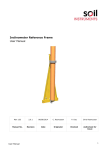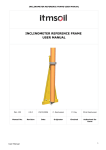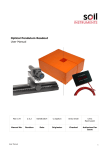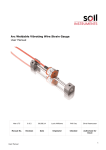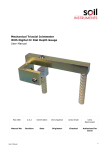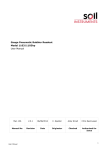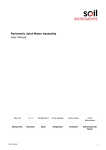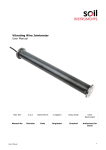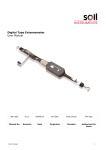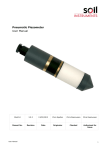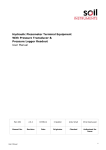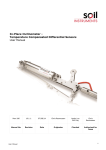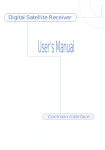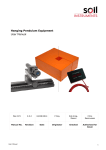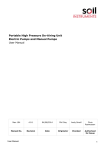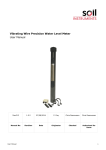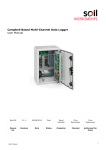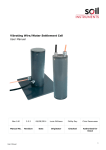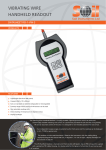Download "user manual"
Transcript
Vibrating Wire Load Cell (3, 4, 5 And 6 Gauge Cells) User Manual Man 188 1.0.2 06/08/2014 Chris Rasmussen Philip Day Chris Rasmussen Manual No. Revision Date Originator Checked Authorised for Issue User Manual 1 Contents Section 1 : Forward ......................................................................................................... 3 Section 2 : Introduction .................................................................................................. 4 Section 3 : Equipment Supplied & Wiring ........................................................................ 5 Section 4 : Preparation ................................................................................................... 6 Section 5 : Installation.................................................................................................... 7 5.01 5.02 Section 6 : User Manual Installation of Load Cells for Rock Bolts and Cable Anchors .................................... 7 Installation of Load Cells for Struts and Columns .................................................. 8 Calibration Certificate & Data Interpretation ................................................. 9 2 Section 1 : Forward This instruction manual, describes the technique required for the installation of centre hole load cells. It is important that the materials and equipment covered by this manual should be installed by competent and suitably qualified personnel. They must READ AND UNDERSTAND the procedures outlined in this manual before attempting installation of the equipment on site. Soil Instruments will not accept for repair under guarantee, instruments/materials neglected or mishandled in any way. The techniques described are intended to serve as a general guide and may vary to suit particular site conditions. User Manual 3 Section 2 : Introduction The Vibrating Wire Hollow Load Cell (V.W.H.L.C.) has been designed for the measurement of loads in rock bolts, single/multi-stranded anchors, structural beams, piles and between tunnel lining segments. The V.W.H.L.C. usually incorporates either three, four, five or six vibrating wire strain gauges mounted parallel to the cells axis of symmetry and equally spaced. The cell is manufactured from a high quality alloy steel, precisely machined and heat treated to provide a stable load bearing ring. Each vibrating wire assembly consists of a tensioned wire clamped at both ends. Located at the mid section of the wire is a coil/magnet. If an electrical pulse is supplied to the coil/magnet the wire will be plucked and oscillate at its natural resonant frequency. A change in applied axial load will be proportional to the change in the square of the resonant frequency of the wire. The coil/magnet then acts as a pickup as the oscillations of the wire through the magnetic field induces an alternating current in the coil which can be detected by a readout unit. The readout converts the sinusoidal alternating voltage to a square waveform which may eaSoil Instrumentsy be timed using a frequency oscillator. In this way the frequency of oscillation can accurately be measured. User Manual 4 Section 3 : Equipment Supplied & Wiring Each cell is supplied with heavy gauge multicore, PVC sheathed cable to the length specified by the user or standard 5 metre length. Cables can be routed over distances in excess of 1000 metres without a degradation of signal. Although cells are checked prior to leaving Soil Instruments, damage could occur during transit. It is suggested that the cells are visually checked immediately upon receipt. Additionally it is prudent to check the operation using a vibrating wire readout device to ensure steady readings. If an audio signal is available on the readout device this can give a good indication of the quality of the signal for each gauge. The cores are identified as follows: CHANNEL User Manual View From Above Non drilled face FUNCTION WIRE COLOUR A Gauge A Red B Gauge B Black C Gauge C Blue D Gauge D Yellow E Gauge E Violet F Gauge F Grey G Shield Bare J Thermistor Green K Thermistor White (6 gauge cell) C D B E A F 5 Section 4 : Preparation WARNING: Do not hit or strike the cell at any time with a hammer or other object. Base readings MUST be established on the unloaded cell prior to installation and after loading has taken place. To ensure instrument stability it is suggested that the load cells are monitored in a controlled environment for as long as possible prior to installation and the readings recorded. Where a number of cells are to be installed it is essential that each cell and its associated cable is accurately and effectively identified. A permanent marking system should be adopted to ensure load cells can be identified throughout their working lifetime and this information safely stored for future reference. It is essential that the load bearing surfaces above and below the cell are smooth and flat, parallel and sufficiently strong to avoid significant distortion under load. Positioning and alignment of the cells is critical to their performance. The surface to which the cell is to be installed should be flat and perpendicular to the anchor. If a steel anchor plate is provided on the structure face, the area to be covered by the cell assembly should be cleaned, in particular removing paint, smoothing out score marks and rough imperfections with a file and abrasive paper. Check that all the items for the installation are readily available i.e. load cell, top and bottom bearing plates, vibrating wire readout unit, calibration data for load cell, anchor stressing equipment and where necessary lifting equipment to support the weight of the load cell. The load cell serial no. and installation location should be checked and recorded. Prior to installation, the cell should be stored close to its installation location to enable the instrument to come into equilibrium with its temperature environment. User Manual 6 Section 5 : Installation 5.01 Installation of Load Cells for Rock Bolts and Cable Anchors 5.1.1 Using the flying lead with crocodile clips supplied with the readout unit connect to gauge A and record the base reading in frequency squared divided by 1000 (F 2/1000) Repeat for gauges ‘B’, ‘C’, ‘D’, ‘E’ and ‘F’ as appropriate. 5.1.2 Carefully locate the bottom bearing plate, load cell and top loading plate over the anchor, followed by the stressing nut and plate (for single strand anchors) or anchor disc and collets (for multistrand anchors).Where centralising recesses or buttons are provided on the plates, ensure that these are correctly located. Suitable lifting tackle may be necessary in some installations to support the weight of the load cell, plates and stressing equipment and to ensure correct alignment is maintained. 5.1.3 With the stressing equipment connected, slowly operate the hydraulic jack to provide sufficient load to lightly hold the load cell assembly against the anchor plate. Check for alignment and concentricity of all the components to ensure that the anchor load is applied in line with the axis of the load cell. 5.1.4 At this stage the gauges for the cell should be read and converted to Engineering Units. Ideally each load reading should be the same, however, in practice this is difficult to achieve, 30% deviation between gauges is usually acceptable as the readings are averaged to obtain axial loading. If reading deviation is within acceptable limits record readings go to stage 6.1.6 otherwise go to stage 5.1.5. 5.1.5 If the reading deviation is not acceptable it will be necessary to de-stress the jack and reposition the cell. If repositioning does not help all loading surfaces should be inspected and cleaned. Repeat stage 5.1.3. 5.1.6 Loading of the anchor should be applied in increments up to the value specified by the Engineer. Readings should be taken at each load increment to check that the load is applied evenly through all the gauges if, at any stage, the deviation of readings becomes unacceptable go to stage 5.1.5. 5.1.7 Prior to locking off the anchor at the required working load a number of loading cycles should be carried out to at least the working load to check the performance of the load cell and ensure that the anchor and load cell are correctly bedded in. 5.1.8 Most installations require the anchor to be tested to a maximum of 1.5 times the eventual working load. The requirement for this operation should be checked and agreed with the Engineer before the final locking off of the anchor. 5.1.9 On completion of the installation the load cell and bearing plates should be heavily greased on all exposed surfaces. 5.1.10 The protective cover must be adequate to protect the load cell from damage as well as differential temperature changes. Reflective external surfaces and internal insulation will help eliminate this effect. User Manual 7 5.02 Installation of Load Cells for Struts and Columns 5.2.1 With the temperature of the Load Cell at equilibrium connect the flylead (fitted with clips) to the readout and to gauge A and record the base reading in Frequency Squared divided by 1000 (F2/1000) units (see readout users manual for further information). Repeat for gauges ‘B’, ‘C’, ‘D’, ‘E’ and ‘F’ as appropriate. These values can now be used to set up your table parameters. 5.2.2 It is recommended that bearing plates are installed between the structural members/reaction and the Load Cell. They will need to be positioned carefully and where necessary fixed in place or supported. (It should be remembered that the bearing plate includes small locating dowels to assist with centralising).Suitable lifting tackle may be necessary in some installations to support the weight of the load cell and plates to ensure correct alignment is maintained. 5.2.3 With the Load Cell positioned where any Axial Load Cell will be transferred, slowly move the structural member into place and generate some pre-load. (This may be only the weight of the column or produced by applying a load via a hydraulic jack). 5.2.4 At this stage the gauges for the cell should be read and converted into Engineering Units. Ideally each reading should be the same, however, in practice this is difficult to achieve, 30% deviation between gauges is usually acceptable as the readings are averaged to obtain axial loading. 5.2.5 If the reading deviation is not acceptable it will be necessary to unload the cell reposition it. If repositioning does not help all loading surfaces should being inspected, cleaned and checked to confirm they are parallel. Repeat stage 5.2.3. 5.2.6 Where possible a number of loading cycles should be carried out to at least the working load to check the performance of the load cell and ensure that the load cell and bearing plates are correctly bedded in. 5.2.7 On completion of the installation the load cell and bearing plates should be heavily greased on all exposed surfaces. 5.2.8 A protective cover adequate to protect the load cell from damage as well as high differential temperature changes, should be fitted to the installation. Reflective external surfaces and internal insulation will help eliminate this effect. User Manual 8 Section 6 : Calibration Certificate & Data Interpretation As with any monitoring system it is essential that all the factors that could possibly affect the readings are recorded and taken into account such as atmospheric conditions and construction activities. Because of the nature of the instrument, monitoring during periods of excessive vibration will cause erroneous readings and should be avoided. Temperature changes have a measurable effect on vibrating wire systems and therefore ambient and differential temperatures should be recorded. It should also be remembered that electronic systems such as readout units are known to be affected by temperature variations. The calibration certificate supplied with the cells is calculated with the calibration information taken in units of Frequency Squared divided by 1000 (F2/1000). It is essential that readings are either taken in F2/1000or converted to F2/1000 in order to apply either the linear or polynomial factors to reduce data to load in kN. Conversion to Engineering Units (i.e. kN) is carried out using the formulae detailed below:Linear Calibration Load (kN) = G (R1 – R0) + K (T1 –T0) Where: G = Linear Gauge Factor from calibration certificate R1 = The current reading in F2/1000 R0 = The original (base) reading in F2/1000 K = The Thermal Factor from the calibration certificate T1 = The current thermistor reading T1 = The original (base) thermistor reading Polynomial Calibration Load (kN) = AR12 + BR1 + C + K (T1 –T0) Where: A = The ‘A’ Polynomial Factor from the calibration certificate B = The ‘B’ Polynomial Factor from the calibration certificate# C = The ‘C’ Polynomial Factor from the calibration certificate R1 = The current reading in F2/1000 K = The Thermal Factor from the calibration certificate T1 = The current thermistor reading T1 = The original (base) thermistor reading User Manual 9 Bell Lane, Uckfield, East Sussex t: +44 (0) 1825 765044 e: [email protected] TN22 1QL United Kingdom f: +44 (0) 1825 744398 w: www.itmsoil.com Soil Instruments Ltd. Registered in England. Number: 07960087. Registered Office: 5th Floor, 24 Old Bond Street, London, W1S 4AW User Manual 10










